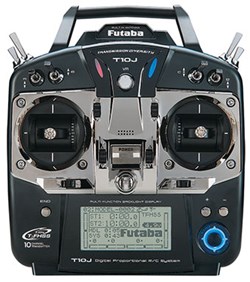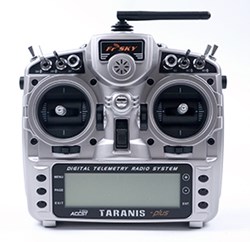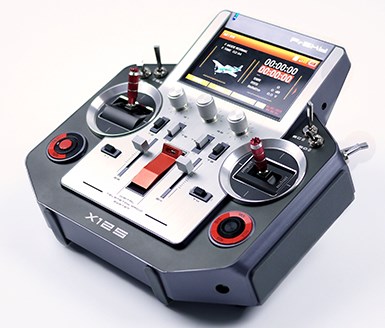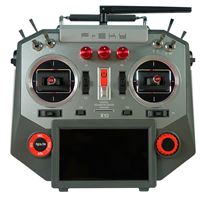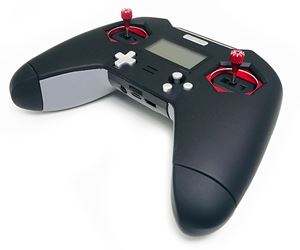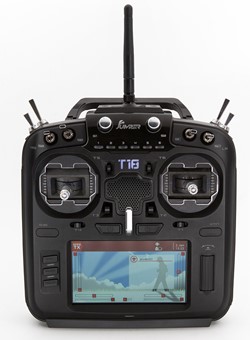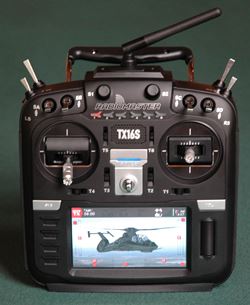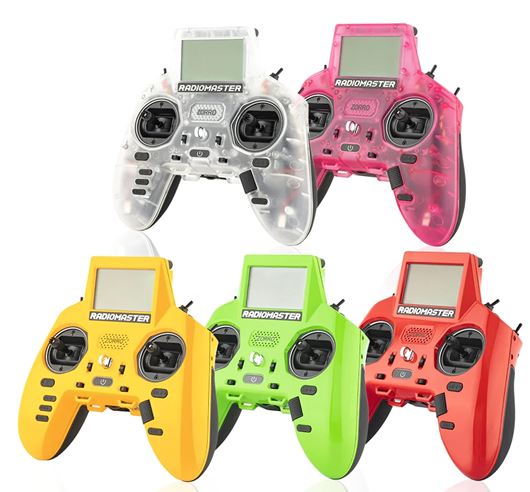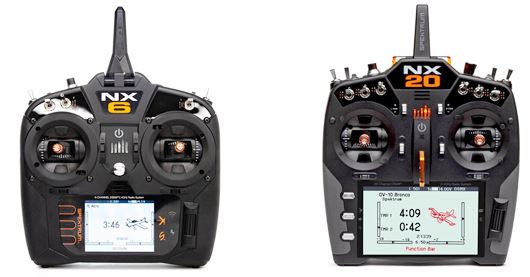Futaba Radios & The Rest
Is Any One RC Transmitter Brand Truly Better?
by John Salt - Updated April 2024
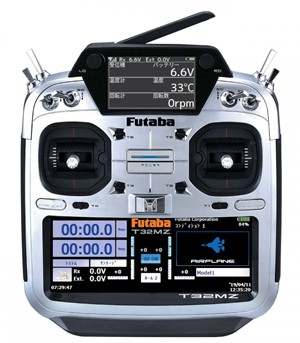 Futaba's 32MZ $3K Flagship RC Radio System - The Cream of the Crop.
Futaba's 32MZ $3K Flagship RC Radio System - The Cream of the Crop.There are several popular RC radio (also called RC transmitters & RC controllers) manufacturers you can choose from when getting into the hobby.
Futaba, FrSky, Graupner, Hitec, Jeti, JR, Jumper, RadioMaster, Spektrum & Mikado's V-Bar Control round out the top 10 main contenders.
There are dozens of other low cost, almost toy grade RC radios on the market as well; but I am focusing on quality hobby grade computerized radios.
Quality computerized radios such as these will give you:
- Years of good performance
- Versatility
- Several to many receiver options
- Flybarless & gyro flight control system compatibility
- Hobby shop and/or online support
- Trouble, worry, and interference free flying
- Won't lock you into some obscure protocol
- Offer good resale value should you wish to upgrade or change systems down the road
So which is best?
Ask ten different people, and you'll likely come up with ten different opinions, heated debates, and discussions.
You see, most RC pilots are very passionate & loyal to the radio/transmitter brand they use, more so than just about any other RC component.
I'm sure you may have read or heard about the so called "brand specific crashes". You know, the Futaba radio users call them "Spektrum Crashes", the Spektrum or JR users call them "Futaba Crashes" and so on.
Unfortunately there is little in the way of supporting data to back those claims up other than known faults with any one brand's specific model/s such as firmware bugs, a bad component, or initial release problems.
As I said on my RC Radio Page, I would not hesitate to say that the majority of "phantom" crashes caused by these so called brand specific radio issues resulted from inadequate voltage/power issues on-board the aircraft, poor antenna placement, or from static discharge and not from radio glitches (assuming correct installation of components of course).
To be honest, all of these manufacturers build really good RC radio systems; way better than what I had to start with 40 years ago. If you're curious, my first RC radio was a 4 channel analog AM frequency Aero-Sport that cost $200 back in 1982 which would be about $700 today. Anyway, brand loyalty plays more of a roll these days than function and performance when seeking purchasing advice.
No longer do you have to pay a premium price to get a good quality RC transmitter these days. Speaking of price, also take receiver and telemetry sensors (if the radio supports telemetry), costs into account. If you see yourself having (or already have), many RC model aircraft for example; choosing one brand over the other based on lower cost receivers and telemetry sensors can save you a lot of money.
This Article I have on my site really dives into the technology behind today's modern 2.4GHz spread spectrum RC radios. It clears up much of the "marketing & brand "X" crash hype" out there.
Sticking with the 10 name brands listed above generally assures you get this build/component quality and then you just have to choose the radio model that has the specific features you're looking for while being within your particular budget.
It could come down to something as simple, but ultimately very important, as how good the radio feels while you are holding it/using it.
- Is the switch and dial placement comfortable/intuitive?
- Is the gimbal placement and reach comfortable for your thumbs (or fingers/thumbs if you fly "pinch")?
- Is the display screen easy to see (low light & outdoors)?
- Does the radio feel balanced in your hands?
- Does the weight feel good?
- Does it have nice soft rubberized grips over hard, slippery plastic?
- Are the corners sharp and dig into your hands, or are they rounded allowing a comfortable grip?
All these ergonomics play a big roll in radio comfort, usability, and ultimately, an RC radio you really enjoy flying with, opposed to one you don't even want to hold.
In other words, if you have a hobby shop that you can visit, or know of someone in your area who has the radio you are considering to actually feel the radio in your paws before ordering/purchasing it; that can be a big advantage to choosing one you will ultimately be happy with.
If you can't access that "hands on" RC radio inspection, use your "Google-fu". Do lots of research on the particular model/s you are considering to at least get an idea of what it feels like from other hobbyists who have the same radio/s.
Consider the radio brand's "protocol."
Most radio system communication protocols are not compatible with each other. This simply means each radio brand talks to the receiver onboard your RC aircraft in it's own "digital language" that is not understood by other brand's receivers.
Radio choice is therefore a fairly permanent one. If you have several RC models for example that have brand A receivers in them and you later decide to convert to a brand B radio, you generally can't; unless you also switch all your receivers to brand B as well.
Depending on how many RC models you have, this can be a very costly and time consuming conversion process. This again is why you want to take your time with your radio brand decision.
Multi-Protocol RC Transmitters - what?
There are a growing number of "Multi-Protocol" RC radio systems these days that you can use with many 2.4 GHz spread spectrum protocols on the market.
Most use open source firmware (OpenTX & Edge TX) that works with multi-protocol RF modules. These systems can be complicated however. R&D testing is also largely up to the users to beta test. It's cool tech & I'm personally a huge fan of open source, but it won't be for everyone.
A good analogy of Open/EdgeTX is like choosing a Linux OS computer system over Window's or Mac. It's not as intuitive for the masses and better suited for RC nerds; but if you happen to be an RC nerd (which I am), Open/Edge TX is powerful, immensely configurable, and because it's open source - very affordable.
Anyway, let's have a look all these 10 radio brands one by one to hopefully help you narrow your RC radio brand decision down to one or two.
Futaba Radios - Always Trusted
I have and will always trust Futaba. I have rarely been let down by any Futaba product.
When I first started out in this hobby decades ago – Futaba radios really were
better than most other RC radio manufacturers. That was then, this is now...
Today Futaba really hits the mark on their intermediate to higher end products.
Their entry level 6J & 6K six channel computerized radios (at least
for RC helicopters) are missing a few important features in my option, and are certainly built to a price point. Not near the quality in other words to their mid to higher level models.
However, once you look past the 6J & K, their 2.4 GHz performance FASST series and affordable S-FHSS series are some of the nicest intermediate & advanced radios on the market right now. As with most of the big name radio brands these days - the intermediate to higher end Futaba radio models support aircraft telemetry.
Telemetry by the way allows you to get real time information back from your model such as voltage levels, RPM, temperature, RF signal strength, etc. It's the single biggest thing to have happened to RC radio technology since the in introduction of 2.4 GHz spread spectrum frequency hopping/shifting.
Futaba has two distinct 2.4GHz spread spectrum protocols - FASST & S-FHSS which are not compatible with each other so that is the one thing to be aware of when choosing a Futaba system or subsequent receivers.
Futaba S-Bus digital communication protocol is also well supported by most high end flybarless systems on the market.
FrSKY Radios - Open Source Beginnings
FrSky has become a very popular RC radio brand for true RC enthusiasts who want massive configuration versatility with an array of RF protocol, receiver & telemetry options, while not breaking the bank.
Impressive RC radio configuration bang for the buck in other words.
FrSky first gained popularity in the quad/multi-rotor world (both FPV & racing), but is now showing up at RC plane & helicopter flying fields in growing numbers world wide.
Originally using OpenTX operating systems, most of FrSky's radios now use FrSky's own ETHOS operating system.
Its two latest frequency hopping protocol called ACCESS (Advanced Communication Control Elevated Spread Spectrum) & ACCST (Advanced Continuous Channel Shifting Technology) are some of the best full range, telemetry enabled, 2.4 GHz spread spectrum protocols on the market today.
ELRS (express LRS) is the latest open source supported RF protocol that FrSky has also embraced in both 900 MHz and 2.4 GHz frequencies.
The fully expandable 16 channel Taranis X9D Plus has been their most popular model, and at about $200.00 USD,
outperforms radios that cost twice as much in terms of
features, performance, and of course versatility.
One of the nicest features with FrSky, indeed many open source radio brands, is you can purchase repair/upgrade parts for them very easily. This is most certainly something none of the other big name brands allow you to do.
The FrSky Horus X12S (replaced by the dual band Tandem X20) are two of the best looking, feature rich, RC radios on the market right now in my opinion.
I actually fly with an X12S myself. I purchased this radio several years ago (2018) to replace my trusty, but aging JR X9503. Getting the display above the neck strap was what initially inspired my decision and it would most certainly be hard going back to a lower display because I love upper display radios now!
The Horus X10 builds on many of the features the X12 offers in a more "traditional" lower display layout many will like better.
The industrial high visibility color display is back to the bottom along with a slightly narrower stick placement. Again, one of the nicest RC radios for the price currently on the market in my opinion.
The FrSky Taranis X-Lite as you can tell takes its design insparation from the gamming community.
For those that love the feel of a game pad in their hands, the Taranis X-Lite is worth checking out.
Graupner Radios - Euro Flair
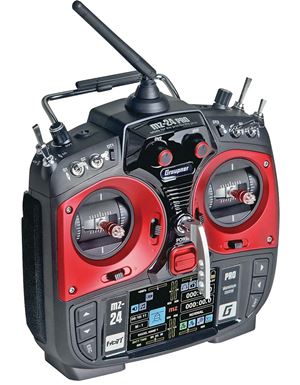 Graupner MZ-24 Radio
Graupner MZ-24 RadioGraupner RC has been around for a long time and has a very loyal following in Europe stemming all the way back to the 1930's.
They were based in Stuttgart Germany, but were purchased by a Korean company back in 2013 while still retaining the original name and expanding the product line.
Graupner radios are of exceptional value and decent quality similar to that of FrSky.
Their 2.4 GHz spectrum protocol is called "HoTT", which stands for "hopping telemetry transmission". As the name implies, telemetry is standard on on their new models, along with touch screen displays, and programmable voice alerts. I'm not a fan of touch screen on RC radios, but we all have different likes and dislikes.
Definitely a brand to check out if you're looking for good value, telemetry, and touch screen displays.
HiTec Radios - Traditional Goodness
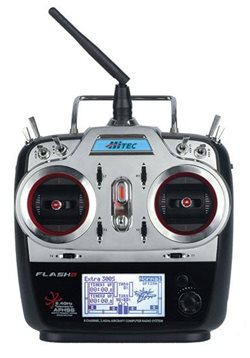 HiTec Flash 8 Radio
HiTec Flash 8 RadioHitec was left behind when 2.4GHz Spread Spectrum Modulation was introduced; but Hitec caught up to this technology and has a small, yet decent lineup of computerized radios which comprise the Flash 8, and Flash 7.
Hitec has made solid quality & reliable radios with very good spread spectrum protocol (currently running 2nd generation AFHSS).
Their Aurora 9 was was one of the first reasonably priced radios on the market with telemetry several years ago which set a bench mark for others and first started the RC radio "telemetry revolution".
Hitec radio's are considered by some to be rather dated and limited in features these days compared to the latest offerings by Futaba, FrSky, Graupner, Jeti, JR, OpenTX & Spektrum. Still, the quality and value is decent; plus they have very nice big clear high contrast displays, and very nice ball raced gimbals.
I do have to wonder given HiTec's limited base and following, if they will be the next RC radio brand to fade into the history books?
JETI Radios - The High End Choice
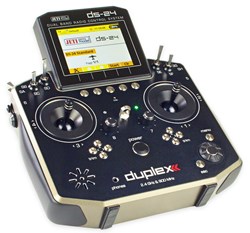 Jeti DS-24 Radio
Jeti DS-24 RadioJeti Duplex are a relatively newer high end RC radio manufacturer out of the Czech Republic and are a favored brand now in the RC helicopter and jet world; with a rapidly growing customer base that are converting over from the likes of Futaba, JR, Spektrum, and HiTec.
A small company that competes, even outpaces, the big players always grabs my attention and Jeti is no exception.
They too have some of the nicest looking & high quality radio's on the market right now in my opinion, and it's pretty easy to see with their $2000.00 flagship DS-24 Jeti radio, where FrSky got its inspiration when creating the $500.00 Horus X12S & Tandem series.
Jeti has high end features such as CNC gimbals with hall effect sensors, top notch quality toggles & switches, a full array of telemetry options, dual redundancy, and a wonderful feature rich user interface firmware.
If you have deeper pockets and want what many consider to simply be the best RC radio system out there right now, Jeti just may be the RC radio brand for you.
JR Radios - They're Back!
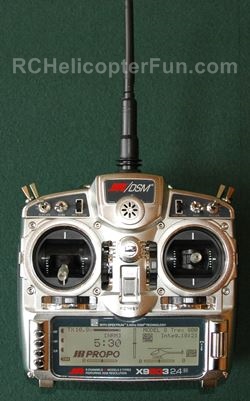 My Trusty JR X9503 Radio
My Trusty JR X9503 RadioAs I already mentioned, my go to radio up until I got the FrSky Horus in 2018 was the JR X9503.
I've had it for just over 10 years (still use it from time to time) and it has never let me down once. A good flying buddy :)
Like Futaba radios, JR Propo (Japan Radio) has been in the RC game for as long as I can remember and has a loyal following.
JR has traditionally built very high end products including radios, receivers, servos, and helicopters. They teamed up with Spektrum to utilize Spektrum's DSM/2/X protocol when 2.4 GHz spread spectrum technology was introduced back in 2005 or so.
JR equipment has and continues to be used by many professional RC pilots world wide.
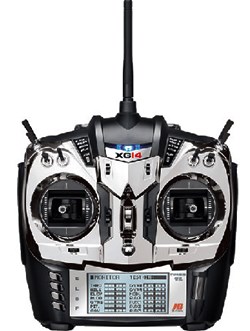 JR DMSS XG14 Radio
JR DMSS XG14 RadioJR then went to its own unique spread spectrum protocol called DMSS (Dual Modulation Spectrum System) around 2013. This new system is not compatible at all
with the Spektrum shared DSM2/X protocol.
Unfortunately, rumors were abound in late 2016 that JR might be going out of business, and this was confirmed by JR when they filed for bankruptcy in late 2017. Soon afterward RC Depo who were affiliated with JR Propo purchased JR rights and restarted the company under new ownership and has rebranded as Dee Force Aviation (DFA) or JR/DFA.
Jumper Radios - OpenTX with Built In Multi-Protocol
Jumper is a fairly new, lower cost Chinese brand proving you don't have to spend a fortune to get a decent quality RC radio system.
Their big claim to fame is coming stock with a "multi-protocol" module meaning you can basically fly almost every brand RX and RTF RC aircraft with their radios.
Their very low cost and small size T8 & T12, are not far off toy quality.
No serious RC hobbyist would take a second glance at them; but they are proving to be fairly popular in the world of low cost micro RC.
However, their new full size T16, T18 and T20 series are another story!
It's pretty easy to see who/what inspired the design - yep the Futaba SZ & MZ series. Hard to mess the outstanding ergonomics up there, and that alone is reason to take a second glance.
Multi-protocol out of the box and able to run open source (Open TX), with color LCD display, running on 2 18650's or 2S LiPo, for under $200 USD.
I've been keeping a close eye on this radio for the past few years and now the new T20. To get all these high end features, hall effect gimbals, built in multi-protocol, 16+ channels, a color display, running OpenTX, for $200 or less; this is arguably one of the best bang for buck RC radio in the business right now.
RadioMaster - Open Source Giant
RadioMaster is another fairly new Chinese brand that has really taken the world of RC by storm. The price and quality of their Open/Edge TX and ELRS based radio systems is hard to ignore making them perhaps the fastest growing radio brand in the past decade.
They now have radios to suit every budget and hobbyist.
My introduction to RadioMaster several years ago was with their ever popular TX16S. I had to see and experience just how much OpenTX or EdgeTX computerized RC radio you can get these days for under $200 USD.
I was and still am amazed at the value and build quality of this radio series. Bang for the buck is off the charts with this RC transmitter!
Like the Jumper T16&18, we can clearly see RadioMaster got its design inspiration from the Futaba SZ series.
For those looking for an Open/EdgeTX radio with built in Multi-Protocol module (ability to fly almost every protocol out there), with all the bells & whistles including color touch screen display, hall effect gimbals, & telemetry but don't want to spend much, this radio is hard, no strike that... impossible to beat!
It and the Jumper T18 are very similar but there are a few little differences that may make one better than the other depending on your specific needs.
I personally like the Radio Master TX16S better for the simple reason it costs slightly less, has internal battery charging & what I consider slightly better build quality. Here's a review video I made going over the "feel & features".
RadioMaster now has several different models of radios ranging from the small "Pocket" series to their colorful game pad inspired Zorro series to the Max Pro versions of the TX16S with either open source multi-protocol or ELRS RF protocols.
Spektrum Radios - The Popular Choice For Many
Love em or hate em, Spektrum continues to dominate the 2.4 GHz spread spectrum RC radio market. This is not because they are any better than the rest, they just build a solid product with features & ease of usability most average RC'ers are after with decent pricing and great product support.
They are also the main brand carried at most brick & mortar RC hobby shops so they simply get more exposure. From the $200 DX6e to their flagship $1400 iX20, Spektrum has several radios (DX6e, DX8e, NX 6,8,10,20, iX14 & iX20) for most budgets.
Spektrum was after all, the first to the spread spectrum game over 15 years ago (at least in the hobby grade RC radio market), and they won a loyal dealer and customer following that continues to this day.
Spektrum wins out hand down from an ease of use, integration, and convenience standpoint offered with Horizon Hobby's BNF (bind and fly), Blade and eFlite aircraft. They all work with Spektrum's DSM2/X protocol, and that is the other big reason Spektrum is so popular and makes a good no-nonsense choice for many; it's all about the convivence!
Spektrum also has a large number of receivers along with their AS3X receivers with built in gyro stabilization for both fixed wing and helicopters, giving you lots of RX options. Moreover, most of today's good FBL systems support Spektrum satellite receiver connectivity and that too is a really nice feature.
Spektrum also integrates its latest NX series radios with their proprietary SMART system components enabling two way telemetry and setup communion with any of their SMART RX's, ESC, and LiPo Battery packs.
I personally don't like being locked into proprietary technology like that (why I now use open source radio systems); however, for those that don't mine being locked in, the connectivity conveniences of SMART can't be understated.
VBar Control by Mikado - The Apple of RC Transmitters
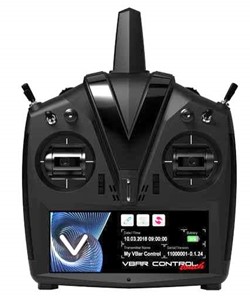 Mikado's VBar Control RC Transmitter - The High-End Heli Choice
Mikado's VBar Control RC Transmitter - The High-End Heli ChoiceMikado out of Germany and their line of Vbar Control RC radios are considered by many serious RC helicopter enthusiasts the best radio system you can invest in.
Mikado's transmitters are stunningly beautiful with a clean & minimalist layout. I liken them to Apple or Tesla products in design, ergonomics, premium price, and propitiatory technology.
With features such as large color touchscreen display, telemetry, integrated ESC setup, and a full array of logged data sets, Vbar Control radios are feature rich.
If you fly your helicopters with the VBar flybarless system; setup, configuration, and tuning & telemetry is about as easy and integrated as it gets. This is what really sets this radio system apart from all others.
